Windows Phone Summit Notes, Part 3: Deep-Dive Demo
 Friday, September 7, 2012 at 4:56PM
Friday, September 7, 2012 at 4:56PM Finishing up my new notes for the Windows Phone Summit from back in June, we hit on the final part of the event, which features Kevin Gallo, who runs the developer platform part of the Windows Phone team. This portion of the event promised more technical specifics around the platform capabilities that Microsoft announced at the June event.
Remember that if you want to follow along, the video version of the event is available on the web or via the Microsoft Keynotes podcast on Zune Marketplace. The Kevin Gallo portion starts at about the 1:06 mark.
Gallo starts off by covering the agenda for his part of the speech. This includes three core bits: A technical overview of the shared Windows core, an early preview of the developer platform, and new platform support for business and enterprise. Since Windows Phone Book (as I currently think of it) is for end users, I’m going to cherry-pick relevant details only from the first two parts of this talk, for background. But obviously the new business stuff is high up on the interest list.
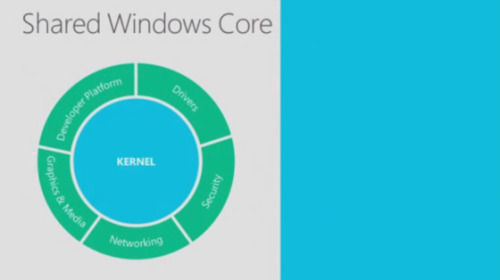
Shared Windows Core
Kernel – Drivers, security, networking, graphics and media, and developer platform layered on top
Based on the state of the art Windows 8 kernel – better scalability (multi-core) and proven robustness
Share the Windows device driver model – A single device driver for phones, tablets, and PCs – graphics, etc.
Hardware-based security of Windows – never regret installing an app because it cannot affect other apps, other apps’ data, or the OS itself. When you remove an app, it’s gone. Your content is also under your control—photos, videos, music, contacts, etc.—you share when you choose only, and only those apps you want to have access.
Networking – IPv6, NFC – Improved Bluetooth support. (need to look into this: BT support on WP7.x is lackluster, only supports a subset of available BT profiles.)
Graphics and media – HW accelerated Direct3D for graphics and for the media foundation – audio and video playback and recording. Highest fidelity possible.
Dev platform – share more code between Windows and WP than before. Native code, .NET code. Windows Phone 8 includes the same .NET version that ships in the Windows 8 desktop. New compile in the cloud feature that lets apps install and run faster on user’s phones.
Shared core benefits everyone
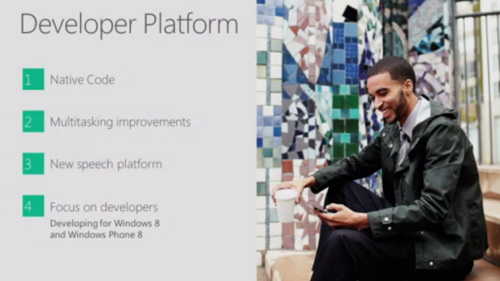
Developer platform – will just mention those things that impact end users here – like multitasking improvements and new speech platform
Native code
Enables amazing games – casual or hardcore
Will speed arrival of high quality games on WP8 – can port from other platforms: Windows, Android, iOS
Some game makers that will be brining games to WP8: Gameloft (Asphalt Heat 7, Nova 3) and Big Fish (Fairway Solitaire)
Demo of game – in-app purchase system
Complete gaming platform on WP8
But native code is also about non-games … apps. Portability. Share code between Winows 8 and WP8. Or from Android and iOS.
Which parts of Windows 8 are identical to developers in Windows Phone 8: Graphics, Audio, Media, File System, Networking, Input, Commerce, Base Types, Sensors
Multitasking – new features added in WP8
Two discussed here:
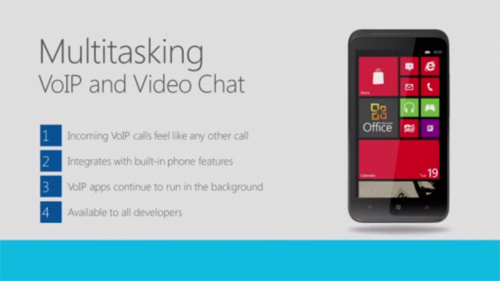
VoIP and video chat deeply integrated into the OS – VoIP call (Skype, third party) looks and feels just like any normal phone call. Runs over lock, etc. Also integrats with phone features like audio routing (BT headset, hands free in-car, will just work) and run over lock. VoIP apps can run in the background. Notification toasts will trigger normally, etc. Isn’t just for Skype: Any third party app can do this.
Second, background location.
Apps that use location can now run in the background. Navigation apps. Find a restaurant but get a text message. Look at it but continue to get directions. Now works in WP8. On device apps and third party apps. Respects battery life, end user experience.
Video demo includes a few interesting bits. Conversations with apps – use the new speech platform to speak to apps. Asks questions. You can answer (yes, no, etc.).
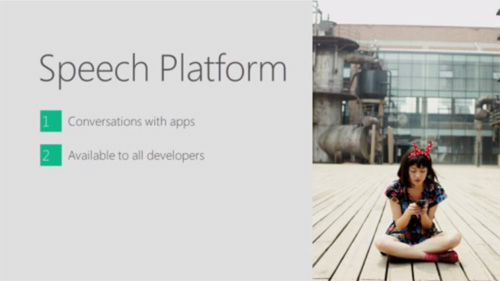
Speech always integral to WP. Launch apps since 7.0.
Demo – worked with Audible to enable speech on their audiobook app. In app, tap mic button in app bar, wait for speech beep and then talk. “Audible … play game of thrones.” “Next chapter.” “Pause.”
Not just app launching. Give it commands. Control behavior.
More complex: “Search.” WP: Heard you say search. What would you like to search for? “Apollo.” WP: I found one title in your library. [Boot title.] Would you like to listen to it? “Yes.”
Basically had a conversation with the app. Two way interactive conversation. Not just with phone. But with app. Available to all developers.
Compatibility – WP7.5 apps will run on Windows Phone 8.

Enterprise support
Complete security platform: Secure boot, full device encryption using BitLocker technologies (like Windows RT)
Flexible app distribution model – business controlled, determine which apps can be installed as well as how to distribute: On prem, cloud-based, up to the company
Device management support for large enterprises (only)
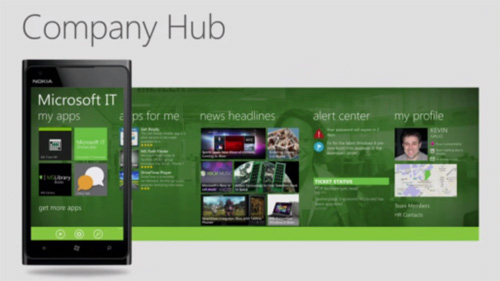
Company hub introduced – Just an app, allows each co to personalize the experience for their employees. They control the app. Which apps to highlight and communicate. Ex: Microsoft’s IT department. Pivots: My Apps (apps the user has installed: Microsoft IT Showcase, My Library, Office Talk, plus get more apps link), Apps for Me (Highlighted apps: MS Time Off, Get Ready, MS Path Finder, DriveTime Player…), News Headlines (company news tiles), Alert Center (Password changes, etc.), My Profile (self service IT area). Installing an app from hub: links to standard Windows Phone Marketplace landing page for app with Install and Share buttons … But it’s completely customizable by every company. (Not sure if that’s true per se.) Install the app. The app does not come from the Marketplace. It comes from the company’s IT infrastructure. (This will require some further research obviously.) Installed, runes normally. Will provide templates and guidance for companies that want to do this.
Wrapping up Gallo portion.
Terry Myerson back, talks hardware a bit
At launch, four hardware OEMs – Nokia, Samsung, HTC, and Huawei. All running on next-generation Qualcomm platform.
Truly global launch: Windows Phone 8 will ship in 50 languages with apps available in over 180 countries. 25 more countries than Apple. Not just a translation but deeply local experiences.
Software updates – our entire ecosystem has been challenged here. Getting new sw out a challenge. Working with partners to do this better. Path that puts the consumer first. Found it with WP8: First step is, all sw updates will be delivered over the air. (Currently all basically required Zune PC software and PC sync.) MS will support every device with updates for at least 18 months from the launch of that device. And third, MS will have a program where “registered enthusiasts” can get early access to updates before any broad consumer push.
Windows Phone 8 will only run on new devices. Not on existing devices. An update for WP 7.5 customers called WP7.8 will provide the new Start experience.
Nokia bit occurs. Not relevant to Windows Phone 8.


Reader Comments (2)
I like the new look Paul. This site/book is coming together nicely. Keep up the good work. I'm still waiting on some conformation of a Windows Phone 8 device on Verizon.
I've been traveling, but I believe Verizon confirmed with CNET that they will have multiple Windows Phone 8 handsets in Q4 2012.